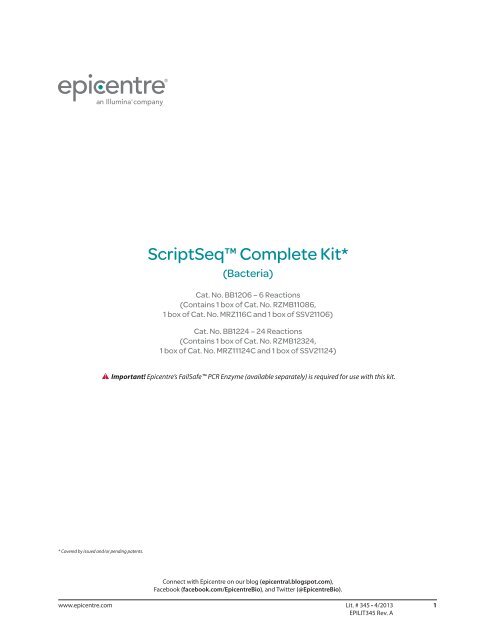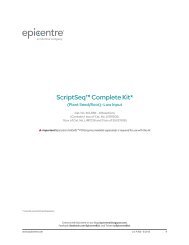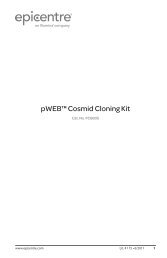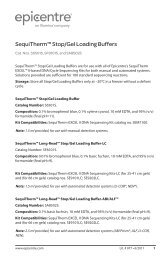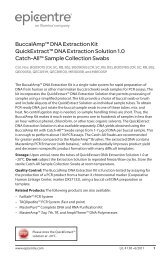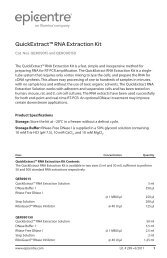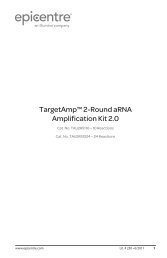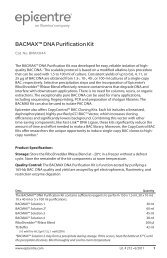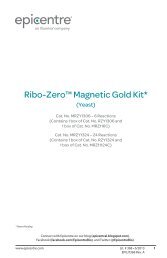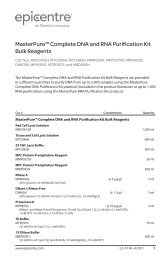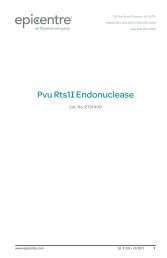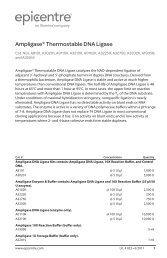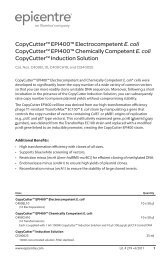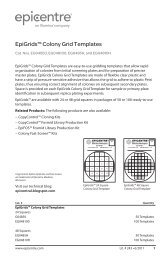Protocol for ScriptSeq⢠Complete Kit (Bacteria)
Protocol for ScriptSeq⢠Complete Kit (Bacteria)
Protocol for ScriptSeq⢠Complete Kit (Bacteria)
You also want an ePaper? Increase the reach of your titles
YUMPU automatically turns print PDFs into web optimized ePapers that Google loves.
ScriptSeq <strong>Complete</strong> <strong>Kit</strong>*<br />
(<strong>Bacteria</strong>)<br />
Cat. No. BB1206 – 6 Reactions<br />
(Contains 1 box of Cat. No. RZMB11086,<br />
1 box of Cat. No. MRZ116C and 1 box of SSV21106)<br />
Cat. No. BB1224 – 24 Reactions<br />
(Contains 1 box of Cat. No. RZMB12324,<br />
1 box of Cat. No. MRZ11124C and 1 box of SSV21124)<br />
Important! Epicentre’s FailSafe PCR Enzyme (available separately) is required <strong>for</strong> use with this kit.<br />
* Covered by issued and/or pending patents.<br />
Connect with Epicentre on our blog (epicentral.blogspot.com),<br />
Facebook (facebook.com/EpicentreBio), and Twitter (@EpicentreBio).<br />
www.epicentre.com Lit. # 345 • 4/2013 1<br />
EPILIT345 Rev. A
ScriptSeq <strong>Complete</strong> <strong>Kit</strong> (<strong>Bacteria</strong>)<br />
Additional RNA-Seq Sample Prep Products<br />
Ribo-Zero rRNA Removal <strong>Kit</strong>s and Globin-Zero Gold <strong>Kit</strong> <strong>for</strong> globin mRNA/rRNA removal are available separately <strong>for</strong> many<br />
sample types, including:<br />
Clinical research samples<br />
Human/Mouse/Rat<br />
Blood<br />
<strong>Bacteria</strong><br />
Plants<br />
Other<br />
ScriptSeq <strong>Complete</strong> <strong>Kit</strong>s, combining a Ribo-Zero rRNA removal or Globin-Zero globin mRNA/rRNA removal module and a<br />
ScriptSeq v2 RNA-Seq Library Preparation <strong>Kit</strong> module, are available <strong>for</strong> many sample types, including:<br />
Clinical research samples<br />
Human/Mouse/Rat<br />
Blood<br />
<strong>Bacteria</strong><br />
Plants<br />
Other<br />
2 www.epicentre.com
ScriptSeq <strong>Complete</strong> <strong>Kit</strong> (<strong>Bacteria</strong>)<br />
Total RNA<br />
Ribo-Zero<br />
rRNA depletion<br />
1.5 hr<br />
cDNA synthesis<br />
3’ Terminal tagging<br />
1.5 hr<br />
(Single tube<br />
workflow)<br />
ScriptSeq v2<br />
Figure 1. An overview of the ScriptSeq<br />
<strong>Complete</strong> <strong>Kit</strong> (<strong>Bacteria</strong>) procedure. rRNA is first<br />
removed from the sample using the Ribo-Zero<br />
Magnetic <strong>Kit</strong> (<strong>Bacteria</strong>). The ScriptSeq v2 RNA-Seq<br />
Library Preparation <strong>Kit</strong> is then used to make the<br />
RNA-Seq library from the Ribo-Zero treated RNA.<br />
PCR and<br />
library purification<br />
2.5 hr<br />
The ScriptSeq <strong>Complete</strong> <strong>Kit</strong> (<strong>Bacteria</strong>) is composed of three boxes:<br />
– Ribo-Zero rRNA Removal Reagents (<strong>Bacteria</strong>)<br />
– Magnetic Core <strong>Kit</strong><br />
– ScriptSeq v2 RNA-Seq Library Preparation <strong>Kit</strong><br />
1. RNA Sample Considerations<br />
DNA-Free RNA<br />
Treat the RNA sample with DNase I to remove all traces of DNA. Then, remove the DNase I prior to the Ribo-Zero reaction. DNA<br />
contamination will interfere with rRNA removal and is the main cause of loss of directionality when sequencing the ScriptSeq<br />
<strong>Complete</strong> library. The RNA sample should be free of salts (e.g., Mg 2+ or guanidinium salts) or organics (e.g., phenol and ethanol).<br />
Amount of RNA<br />
The Ribo-Zero process uses 1-5 µg of DNA-free RNA. The sample should be dissolved in RNase-Free Water or TE Buffer. It is important<br />
to quantify the amount of total RNA in the sample as accurately as possible in order to use the appropriate amount of Ribo-Zero rRNA<br />
Removal Solution in Part 3.B. Use Table 1 (Part 3.B) to determine the maximum volume in which the total RNA sample can be dissolved<br />
prior to per<strong>for</strong>ming the Ribo-Zero procedure.<br />
techhelp@epicentre.com • (800) 284-8474 3
ScriptSeq <strong>Complete</strong> <strong>Kit</strong> (<strong>Bacteria</strong>)<br />
2. <strong>Kit</strong> Contents and Specifications<br />
Ribo-Zero <strong>Kit</strong> (<strong>Bacteria</strong>)–Used in Section 1<br />
The kit components are supplied in tubes with colored caps <strong>for</strong> easier identification.<br />
Each kit contains one box of Cat. No. RZMB11086/RZMB12324 and one box of Cat. No. MRZ116C/MRZ11124C.<br />
Ribo-Zero rRNA Removal Reagents (<strong>Bacteria</strong>) (Cat. No. RZMB11086/RZMB12324)<br />
Volume<br />
Component Name<br />
Tube Label<br />
6-rxn<br />
24-rxn<br />
Cap Color<br />
RiboGuard RNase Inhibitor (100 U/μl) RiboGuard RNase Inhibitor 10 μl 30 μl<br />
Ribo-Zero rRNA Removal Solution (<strong>Bacteria</strong>) rRNA Removal Solution–(<strong>Bacteria</strong>) 75 μl 270 μl<br />
Ribo-Zero Reaction Buffer Ribo-Zero Reaction Buffer 50 μl 110 μl<br />
Glycogen (10 mg/ml) Glycogen 20 μl 60 μl<br />
Sodium Acetate (3 M) Sodium Acetate 150 μl 500 μl<br />
RNase-Free Water RNase-Free Water 2 x 1 ml 3 x 1.5 ml<br />
Storage: Store this kit box and its contents at –70°C to –80°C.<br />
Blue<br />
Clear<br />
Magnetic Core <strong>Kit</strong> (Cat. No. MRZ116C/MRZ11124C)–Used in Section 1<br />
Component Name<br />
Tube Label<br />
6-rxn<br />
Volume<br />
24-rxn<br />
Cap Color<br />
Magnetic Beads Magnetic Beads 1.4 ml 5.4 ml Clear<br />
Magnetic Bead Resuspension Solution Magnetic Bead Resuspension Solution 500 μl 2 ml Yellow/Clear<br />
RNase-Free Water RNase-Free Water 3 ml 2 x 5.5 ml Clear<br />
Storage: Store this kit box and its contents at 4°C (Do Not Freeze!).<br />
Additional Required Reagents and Equipment <strong>for</strong> the Ribo-Zero procedure:<br />
Magnetic rack or stand <strong>for</strong> 1.5 ml tubes<br />
0.2-ml or 0.5-ml and 1.5 ml microcentrifuge tubes (RNase-free)<br />
Thermocycler or other temperature control device <strong>for</strong> 0.2-ml or 0.5-ml tubes<br />
Water bath, heating block, or other temperature control device <strong>for</strong> 1.5-ml tubes<br />
RNA purification kits such as Agencourt RNAClean XP <strong>Kit</strong> (Beckman Coulter), or Qiagen RNeasy MinElute® Cleanup <strong>Kit</strong>,<br />
or ice-cold 100% and 70% ethanol <strong>for</strong> ethanol precipitation<br />
Vortex mixer<br />
ScriptSeq v2 RNA-Seq Library Preparation <strong>Kit</strong>–Catalog No. SSV21106/SSV21124–Used in Section 2<br />
Volume<br />
Component Name<br />
Tube Label<br />
6-rxn 24-rxn Cap Color<br />
ScriptSeq v2 cDNA Synthesis Primer cDNA Primer 18 µl 55 µl<br />
RNA Fragmentation Solution Fragmentation Solution 10 μl 30 μl<br />
Green<br />
ScriptSeq v2 cDNA Synthesis PreMix cDNA Synthesis PreMix 25 μl 80 µl<br />
100 mM DTT 100 mM DTT 100 μl 100 μl<br />
StarScript Reverse Transcriptase StarScript Reverse Transcriptase 8 μl 15 µl<br />
Red<br />
ScriptSeq Finishing Solution Finishing Solution 10 μl 30 µl<br />
ScriptSeq v2 Terminal Tagging PreMix Terminal Tagging PreMix 60 μl 200 µl<br />
DNA Polymerase DNA Polymerase 8 μl 15 µl<br />
Blue<br />
Exonuclease I Exo I 10 µl 30 µl<br />
FailSafe PCR PreMix E FailSafe PCR PreMix E 200 μl 650 µl<br />
Forward PCR Primer Forward PCR Primer 10 μl 30 µl<br />
Yellow<br />
Reverse PCR Primer Reverse PCR Primer 10 μl 30 µl<br />
Nuclease-Free Water Nuclease-Free Water 500 μl 500 µl Clear<br />
Storage: Store the kit at –20°C in a freezer without a defrost cycle.<br />
4 www.epicentre.com
ScriptSeq <strong>Complete</strong> <strong>Kit</strong> (<strong>Bacteria</strong>)<br />
Additional Required Reagents and Equipment <strong>for</strong> the ScriptSeq v2 <strong>Kit</strong> procedure:<br />
FailSafe PCR Enzyme Mix (Epicentre)<br />
Optional: MinElute PCR Purification columns (Qiagen)<br />
Optional: Agencourt AMPure XP System (Beckman Coulter) and magnetic plate, rack, or stand <strong>for</strong> 1.5-ml tubes<br />
Per<strong>for</strong>mance Specifications and Quality Control<br />
A Ribo-Zero Magnetic <strong>Kit</strong> (<strong>Bacteria</strong>) reaction removes >99% of 16S and 23S rRNA, and >95% of 5S rRNA from Gram-positive and Gramnegative<br />
bacterial total RNA as assessed by qRT-PCR be<strong>for</strong>e and after a Ribo-Zero Magnetic <strong>Kit</strong> reaction.<br />
The ScriptSeq v2 RNA-Seq Library Preparation <strong>Kit</strong> is function-tested in a control reaction using 5 ng of rat liver poly(A) RNA. At least<br />
400 ng of a di-tagged library must be produced in a final volume of 20 μl, with a size distribution of 100-1,000 bp, and a peak range of<br />
150-300 bp as assayed using an Agilent Bioanalyzer.<br />
3. <strong>Kit</strong> Procedure<br />
Section 1: The Ribo-Zero rRNA removal procedure<br />
Quick <strong>Protocol</strong> <strong>for</strong> Ribo-Zero <strong>Kit</strong> (<strong>Bacteria</strong>)<br />
For experienced users only! The detailed procedure begins at Step 3.A<br />
Step Procedure Pages<br />
Prepare Magnetic Beads<br />
Treat sample with rRNA Removal<br />
Solution<br />
Remove rRNA<br />
Add 225 µl Magnetic Beads to RNase-free tube.<br />
Place in magnetic stand <strong>for</strong> 1 minute at RT.<br />
Wash with 225 µl RNase-Free Water.<br />
Place in magnetic stand, repeat wash step.<br />
Resuspend in 65 µl Resuspension Solution<br />
Optional: Add 1 µl RiboGuard RNase Inhibitor<br />
Mix in 40 µl total volume:<br />
1-5 µg total RNA<br />
8-10 µl rRNA Removal Solution<br />
4 µl Reaction Buffer<br />
Incubate 10 min @ 68˚C, then 5 minutes @ RT<br />
Mix previously prepared Magnetic Beads<br />
Add RNA mixture, mix well by pipetting, vortex briefly<br />
Incubate 5 minutes @ RT, vortex<br />
Incubate 5 minutes @ 50˚C<br />
Place in magnetic stand, transfer supernatant (rRNA-depleted<br />
sample) to RNase-free tube<br />
Purify rRNA-depleted sample Ethanol precipitation or alternative method 7<br />
5<br />
6<br />
7<br />
3.A. Preparation of the Magnetic Beads<br />
Required in Part 3.A<br />
Component Name Tube Label Cap Color<br />
Magnetic Beads<br />
RNase-Free Water<br />
Magnetic Beads<br />
RNase-Free Water<br />
Magnetic Bead Resuspension Solution Magnetic Bead Resuspension Solution Yellow/Clear<br />
RiboGuard RNase Inhibitor (100 U/μl) RiboGuard RNase Inhibitor Blue<br />
Clear<br />
Important! Allow the Magnetic Core <strong>Kit</strong> components to equilibrate to room temperature be<strong>for</strong>e proceeding!<br />
Remove the Ribo-Zero rRNA Removal Reagents from –70°C to –80°C storage, thaw the tubes, and place them on ice. Wash the beads by<br />
using either the batch washing or individual washing procedure.<br />
techhelp@epicentre.com • (800) 284-8474 5
ScriptSeq <strong>Complete</strong> <strong>Kit</strong> (<strong>Bacteria</strong>)<br />
3.A.1. Batch Washing Procedure<br />
1. For each Ribo-Zero reaction, 225 µl of the Magnetic Beads is required.<br />
Note: Mix the Magnetic Beads well by pipetting or gentle vortexing.<br />
2. Determine the amount of Magnetic Beads required <strong>for</strong> the total number of reactions and dispense a maximum of 1,350 µl into<br />
each 1.5-ml RNase-free microcentrifuge tube (sufficient <strong>for</strong> six reactions). Pipet the Magnetic Bead suspension slowly to avoid air<br />
bubbles and to ensure pipetting of the correct volume. Store unused Magnetic Beads at 4°C.<br />
Note: When setting up more than six Ribo-Zero reactions, either multiples of 1,350-µl aliquots can be washed in a RNase-free 1.5 ml<br />
microcentrifuge tubes, or a larger volume can be washed in RNase-free 15-ml tubes (e.g., using a 15-ml magnetic stand).<br />
3. Place the 1.5-ml microcentrifuge tube containing the Magnetic Beads on the magnetic stand <strong>for</strong> at least 1 minute (until the<br />
solution appears clear).<br />
4. With the 1.5-ml microcentrifuge tube still on the stand, remove and discard the supernatant.<br />
Caution: The supernatant contains 0.1% sodium azide.<br />
5. Remove the 1.5-ml microcentrifuge tube from the stand and add an equal volume of RNase-Free Water. Mix well by repeated<br />
pipetting or by vortexing at medium speed.<br />
6. Repeat steps 3, 4 and 5 (i.e. wash the beads a total of 2 times with RNase-Free water).<br />
7. Remove the 1.5-ml microcentrifuge tube from the magnetic stand. Add a volume of Magnetic Bead Resuspension Solution equal<br />
to the number of reactions x 60 µl (e.g., <strong>for</strong> 6 reactions, add 6 x 60 µl = 360 µl Magnetic Bead Resuspension Solution). Mix well by<br />
repeated pipetting or by vortexing at medium speed.<br />
Note: The volumes of the beads and Resuspension Solution are additive. Although the washed beads are resuspended in 60 µl per<br />
reaction, each reaction uses 65 µl of resuspended beads.<br />
8. Aliquot 65 µl of the washed Magnetic Beads into each new 1.5-ml RNase-free microcentrifuge tube (corresponding to the number<br />
of Ribo-Zero reactions).<br />
9. Optional: Add 1 µl of RiboGuard RNase Inhibitor to each tube of resuspended Magnetic Beads, and mix briefly by vortexing.<br />
10. Store the microcentrifuge tubes at room temperature until required in Part 3.C.<br />
3.A.2. Individual Washing Procedure<br />
Note: Mix the Magnetic Beads well by pipetting or gentle vortexing.<br />
1. For each reaction, pipet 225 µl of Magnetic Beads into a 1.5-ml RNase-free microcentrifuge tube. Pipet the Magnetic Bead<br />
suspension slowly to avoid air bubbles and to ensure pipetting of the correct volume. Store unused Magnetic Beads at 4°C.<br />
2. Place each 1.5-ml microcentrifuge tube on the magnetic stand <strong>for</strong> at least 1 minute (until the solution appears clear).<br />
3. With the 1.5-ml microcentrifuge tube still on the stand, remove and discard the supernatant.<br />
Caution: The supernatant contains 0.1% sodium azide.<br />
4. Remove the 1.5-ml microcentrifuge tube from the magnetic stand and add 225 µl of RNase-Free Water to each tube. Mix well by<br />
repeated pipetting or vortexing at medium speed.<br />
5. Repeat steps 2, 3 and 4 (i.e. wash the beads a total of 2 times with RNase-Free water).<br />
6. Remove the 1.5-ml microcentrifuge tube from the magnetic stand. Add 65 µl of Magnetic Bead Resuspension Solution to each<br />
tube. Mix well by repeated pipetting or vortexing at medium speed.<br />
7. Optional: Add 1 µl of RiboGuard RNase Inhibitor to each tube of resuspended Magnetic Beads, and mix briefly by vortexing.<br />
8. Store the microcentrifuge tubes at room temperature until required in Part 3.C.<br />
3.B. Treatment of the Total RNA Sample with Ribo-Zero rRNA Removal Solution<br />
Required in Part 3.B<br />
Component Name Tube Label Cap Color<br />
Ribo-Zero Reaction Buffer<br />
Ribo-Zero rRNA Removal Solution (<strong>Bacteria</strong>)<br />
Ribo-Zero Reaction Buffer<br />
rRNA Removal Solution (<strong>Bacteria</strong>)<br />
RNase-Free Water RNase-Free Water Clear<br />
Additionally required <strong>for</strong> each reaction (provided by user):<br />
Magnetic stand or rack<br />
0.2-ml or 0.5-ml microcentrifuge tube (RNase-free)<br />
Vortex mixer<br />
Blue<br />
6 www.epicentre.com
ScriptSeq <strong>Complete</strong> <strong>Kit</strong> (<strong>Bacteria</strong>)<br />
Important! The maximum volume of the RNA sample and the volume of the Ribo-Zero rRNA Removal Solution used per reaction is<br />
dependent on the amount of total RNA in the sample (see Table 1).<br />
Table 1. Volumes of Ribo-Zero rRNA Removal Solution.<br />
Amount of Input<br />
Total RNA<br />
Maximum Volume of Total<br />
RNA That Can Be Added to<br />
Each Reaction<br />
Volume of Ribo-Zero rRNA<br />
Removal Solution Used per<br />
Reaction<br />
1-2.5 μg 28 μl 8 μl<br />
>2.5 μg - 5 μg 26 μl 10 μl<br />
1. In a 0.2-ml or 0.5-ml RNase-free microcentrifuge tube, combine in the order given:<br />
x μl RNase-Free Water<br />
4 μl Ribo-Zero Reaction Buffer<br />
1-5 μg Total RNA sample (see Table 1)<br />
y μl Ribo-Zero rRNA Removal Solution (see Table 1)<br />
40 μl Total volume<br />
2. Gently mix the reaction(s) by pipetting and incubate at 68°C <strong>for</strong> 10 minutes. Store the remaining Ribo-Zero rRNA Removal Solution<br />
and Ribo-Zero Reaction Buffer at –70°C to –80°C.<br />
3. Remove the reaction tube(s) and incubate each at room temperature <strong>for</strong> 5 minutes.<br />
3.C. Magnetic Bead Reaction and rRNA Removal<br />
Required in Part 3.C: 50°C water bath or heating block <strong>for</strong> 2.0-ml tubes.<br />
1. Using a pipette, add the treated RNA from Part 3.B to the 1.5-ml microcentrifuge tube containing the washed Magnetic Beads and,<br />
without changing the pipet tip, immediately and thoroughly mix the contents of the tube by pipetting at least 10 times. Then,<br />
vortex the tube immediately at medium setting <strong>for</strong> 10 seconds and place at room temperature. Repeat this process <strong>for</strong> each<br />
sample.<br />
Important! Always add the treated RNA sample to the washed Magnetic Beads and immediately mix by pipetting. Never add the<br />
Magnetic Beads to the treated RNA sample. Immediate and thorough mixing prevents the beads from <strong>for</strong>ming clumps that can<br />
significantly impact the efficiency of the rRNA removal.<br />
2. Incubate the 1.5 ml microcentrifuge tube at room temperature <strong>for</strong> 5 minutes.<br />
3. Following incubation, mix the reactions by vortexing at medium speed <strong>for</strong> 10 seconds and then place at 50°C <strong>for</strong> 5 minutes in an<br />
appropriate water bath or heating block. Avoid any significant condensation during this incubation step.<br />
4. After the 5-minute incubation at 50°C, remove the microcentrifuge tubes and immediately place them on a magnetic stand <strong>for</strong> at<br />
least 1 minute (until the solution appears clear).<br />
5. Carefully remove each supernatant (85-90 µl) containing the RNA and transfer to a labeled 1.5-ml RNase-free microcentrifuge<br />
tube.<br />
Important! The supernatant contains rRNA-depleted RNA.<br />
Optional: If a small amount of Magnetic Beads are still visible in the supernatant, place the collected supernatant onto the magnetic<br />
stand <strong>for</strong> 1 minute. Remove the supernatant containing the rRNA-depleted RNA and transfer to a new 1.5-ml RNase-free microcentrifuge<br />
tube.<br />
6. Place the supernatant (RNA solution) on ice and immediately proceed to Part 3.D. Alternatively, the supernatant may be stored at<br />
–70°C to –80°C be<strong>for</strong>e completing Part 3.D.<br />
3.D. Purification of the rRNA-Depleted Sample<br />
The rRNA-depleted samples can be purified by three methods: ethanol precipitation, AMPure beads, or spin columns. Ethanol<br />
precipitation and the modified RNeasy MinElute procedure provide optimal recovery of small RNAs that may be lost with other<br />
purification methods; however, ethanol precipitation can be challenging <strong>for</strong> inexperienced users. We also provide an alternative<br />
protocol using AMPure beads (provided by the user) <strong>for</strong> ease of automation but this will not quantitatively recover small RNAs.<br />
3.D.1. Ethanol Precipitation of the rRNA-Depleted Sample<br />
Component Name Tube Label Cap Color<br />
RNase-Free Water<br />
Sodium Acetate (3 M)<br />
Glycogen (10 mg/ml)<br />
RNase-Free Water<br />
Sodium Acetate<br />
Glycogen<br />
Clear<br />
techhelp@epicentre.com • (800) 284-8474 7
ScriptSeq <strong>Complete</strong> <strong>Kit</strong> (<strong>Bacteria</strong>)<br />
Additionally required <strong>for</strong> each reaction (provided by user):<br />
1.5-ml microcentrifuge tube (RNase-free)<br />
Ice-cold 70% and 100% ethanol<br />
1. Adjust the volume of each sample to 180 μl using RNase-Free Water.<br />
2. Add 18 μl of 3 M Sodium Acetate to each tube.<br />
3. Add 2 μl of Glycogen (10 mg/ml) to each tube and mix by gentle vortexing.<br />
4. Add three volumes (600 μl) of ice-cold 100% ethanol to each tube and mix thoroughly by gentle vortexing.<br />
5. Place the tubes at –20°C <strong>for</strong> at least 1 hour.<br />
6. Centrifuge the tubes at >10,000 x g in a microcentrifuge <strong>for</strong> 30 minutes. Carefully remove and discard the supernatant.<br />
7. Wash the pellet with ice-cold 70% ethanol and centrifuge at >10,000 x g <strong>for</strong> 5 minutes. Carefully remove and discard the<br />
supernatant.<br />
8. Repeat Step 7 (above) one more time.<br />
9. Centrifuge briefly to collect any residual supernatant. Carefully remove and discard the supernatant and allow the pellet to air dry<br />
at room temperature <strong>for</strong> 5 minutes.<br />
10. Dissolve the pellet in 10 μl of RNase-Free Water or buffer. The Ribo-Zero-treated RNA can be used immediately or stored at –70°C<br />
to –80°C.<br />
3.D.2. Agencourt RNAClean XP <strong>Kit</strong> (Cat. No. A63987, Beckman Coulter)<br />
Note: A fresh 80% ethanol solution is required <strong>for</strong> Steps 5 and 7 below.<br />
1. Vortex the AMPure RNAClean XP Beads until they are well dispersed, then add as follows:<br />
Add 160 μl of the mixed AMPure XP Beads to each 1.5-ml microcentrifuge tube containing 85-90 µl of rRNA-depleted RNA from<br />
Part 3.C, Step 6. Mix thoroughly by gently pipetting the entire volume 10 times.<br />
2. Incubate the tube(s) at room temperature <strong>for</strong> 15 minutes. During incubation, prepare 80% ethanol solution required <strong>for</strong> Steps 5<br />
and 7.<br />
3. Place the tube(s) on the magnetic stand at room temperature <strong>for</strong> at least 5 minutes (until the liquid appears clear).<br />
4. Remove and discard the supernatant from each tube. Do not disturb the beads.<br />
5. With the tube(s) still on the magnetic stand, add 200 μl of freshly prepared 80% ethanol to each tube, without disturbing the<br />
beads.<br />
6. Incubate at room temperature <strong>for</strong> at least 30 seconds while still on the magnetic stand. Then remove and discard all of the<br />
supernatant from each tube. Do not disturb the beads.<br />
7. Repeat Steps 5 and 6 (total of two 80% ethanol washes).<br />
8. Allow the tubes to air dry on the magnetic stand at room temperature <strong>for</strong> 15 minutes.<br />
9. Add 11 µl of RNase-Free water to each tube.<br />
10. Thoroughly resuspend the beads by gently pipetting 10 times.<br />
11. Incubate the tubes at room temperature <strong>for</strong> 2 minutes.<br />
12. Place the tubes back onto the magnetic stand at room temperature <strong>for</strong> at least 5 minutes (until the liquid appears clear).<br />
13. Transfer the clear supernatant from each tube to an appropriate collection tube, always leaving at least 1 μl of the supernatant<br />
behind to avoid carryover of magnetic particles. Store on ice <strong>for</strong> immediate use or store at –70°C or –80°C until required.<br />
3.D.3. RNeasy MinElute Cleanup <strong>Kit</strong> (Cat. No. 74204, Qiagen)<br />
Note: RNA purification kits from other suppliers may also be used; however, per<strong>for</strong>mance may vary.<br />
1. Adjust the sample to a volume of 100 μl with RNase-Free Water. Add 350 μl of Buffer RLT, and mix well.<br />
2. Add 550 μl of 96%-100% ethanol to the RNA, and mix well by pipetting. Do not centrifuge.<br />
3. Transfer half of the sample (~500 µl) to an RNeasy MinElute spin column placed in a 2-ml collection tube (supplied in the Qiagen<br />
kit). Close the lid gently, and centrifuge <strong>for</strong> 15 seconds at 8,000 x g (~10,000 rpm). Discard the flow-through. Reuse the collection<br />
tube <strong>for</strong> Step 5.<br />
4. Transfer the remaining sample and repeat the centrifugation. Discard the flow-through and collection tube.<br />
5. Place the RNeasy MinElute spin column in a new 2-ml collection tube (supplied in the Qiagen kit). Add 500 μl Buffer RPE to the<br />
spin column. Close the lid gently, and centrifuge <strong>for</strong> 15 seconds at 8,000 x g (~10,000 rpm) to wash the spin-column membrane.<br />
Discard the flow-through.<br />
Note: Buffer RPE is supplied as a concentrate. Ensure that ethanol is added to Buffer RPE be<strong>for</strong>e use.<br />
8 www.epicentre.com
ScriptSeq <strong>Complete</strong> <strong>Kit</strong> (<strong>Bacteria</strong>)<br />
6. Add 500 μl of 80% ethanol to the RNeasy MinElute spin column. Close the lid gently, and centrifuge <strong>for</strong> 2 minutes at 8,000 x g<br />
(~10,000 rpm) to wash the spin-column membrane. Discard the flow-through and collection tube.<br />
Note: After centrifugation, carefully remove the RNeasy MinElute spin column from the collection tube so that the column does not<br />
contact the flow-through. Otherwise, carryover of ethanol will occur.<br />
7. Place the RNeasy MinElute spin column in a new 2-ml collection tube (supplied in the Qiagen kit).<br />
8. Open the lid of the spin column, and centrifuge at full speed <strong>for</strong> 5 minutes. Discard the flow-through and collection tube.<br />
9. To avoid damage to the spin-column lids, place the spin columns into the centrifuge with at least one empty position between<br />
columns. Orient the lids so that they point in a direction opposite to the rotation of the rotor (i.e., if the rotor rotates clockwise,<br />
orient the lids counterclockwise).<br />
10. It is important to dry the spin-column membrane since residual ethanol may interfere with downstream applications.<br />
Centrifugation with the lids open ensures that no ethanol is carried over during RNA elution.<br />
11. Place the RNeasy MinElute spin column in a new 1.5-ml collection tube (supplied in the Qiagen kit). Add 12 μl of RNase-Free Water<br />
directly to the center of the spin-column membrane. Close the lid gently, and centrifuge <strong>for</strong> 1 minute at full speed to elute the<br />
RNA. Recovery is usually 10 μl.<br />
The eluted RNA can be used immediately or stored at –70°C to –80°C.<br />
4. Be<strong>for</strong>e Proceeding to ScriptSeq v2 Library Preparation<br />
It is not necessary, but if desired the quality of the Ribo-Zero treated RNA can be assessed be<strong>for</strong>e proceeding to the ScriptSeq v2<br />
Library prep procedure in Section 2. If assessing the quality of the Ribo-Zero treated RNA using an Agilent 2100 Bioanalyzer, use the<br />
Agilent RNA6000 Pico Chip and load 2-4 ng of the Ribo-Zero treated RNA. The Agilent RNA Nano Chip does not provide sufficient<br />
sensitivity. Note that if the Ribo-Zero treated RNA was purified by ethanol precipitation in Step 3.D.1, small RNAs such as tRNA are<br />
recovered along with the mRNAs and large noncoding RNAs. There<strong>for</strong>e, the presence of a high proportion of small RNA in the Ribo-<br />
Zero treated sample should not be interpreted as degradation of the RNA.<br />
For the Ribo-Zero-treated RNA, use Table 2 as a guide to the maximum volume of the purified RNA to use in ScriptSeq v2 library<br />
preparation. The indicated volume corresponds to to the amount of Ribo-Zero treated RNA typically recovered from 1 ug of total RNA.<br />
Note: Ribo-Zero-treated RNA purified by any of the three methods described in Part 3.D will be recovered in approximately 10 µl of<br />
RNase-Free Water.<br />
Table 2. Volume of Ribo-Zero-treated RNA to use in ScriptSeq v2 library preparation.<br />
RNA Sample<br />
<strong>Bacteria</strong><br />
Amount of Total RNA Used in the<br />
Ribo-Zero Procedure<br />
Maximum Volume of Purified Ribo-Zero-<br />
Treated RNA <strong>for</strong> ScriptSeq v2 Reaction<br />
1 µg 9 µl<br />
2.5 µg 4 µl<br />
5 µg 2 µl<br />
techhelp@epicentre.com • (800) 284-8474 9
ScriptSeq <strong>Complete</strong> <strong>Kit</strong> (<strong>Bacteria</strong>)<br />
5'<br />
500 pg to 50 ng rRNA-depleted Ribo-Zero treated or poly(A) RNA + RNA<br />
(AAAA)<br />
Random Hexamer with<br />
Tagging Sequence<br />
3' NNNNNN<br />
Tagging<br />
Sequence<br />
Fragment RNA<br />
Anneal cDNA Synthesis Primer<br />
Synthesize cDNA<br />
5'<br />
3' NNNNNN<br />
3'<br />
NNNNNN<br />
(AAAA)<br />
Remove RNA<br />
3' 5'<br />
Terminal-Tagging Oligo (TTO)<br />
3'-end blocked 5' NNNNNX<br />
Tagging<br />
Sequence<br />
Anneal TTO<br />
Synthesize DNA<br />
5' NNNNNX<br />
3' 5'<br />
Purify cDNA<br />
Di-tagged cDNA<br />
3' 5'<br />
PCR Primers<br />
Amplify by PCR<br />
Index/Bar Code (optional)<br />
5' 3'<br />
3' 5'<br />
Adaptor-tagged RNA-Seq library<br />
<strong>for</strong> directional sequencing<br />
Bar Code<br />
(optional)<br />
Figure 2. An overview of the procedure <strong>for</strong> the ScriptSeq v2 RNA-Seq Library Preparation <strong>Kit</strong>.<br />
10 www.epicentre.com
Section 2. The ScriptSeq v2 RNA-Seq Library Preparation Procedure<br />
Quick <strong>Protocol</strong> <strong>for</strong> ScriptSeq v2 RNA-Seq Library Preparation <strong>Kit</strong><br />
For experienced users only! The detailed procedure begins at Step 5.<br />
Step Procedure Pages<br />
Fragment RNA If using severely fragmented RNA, go to Appendix 1.<br />
1. Mix the following:<br />
x µl Nuclease-Free Water<br />
y µl Ribo-Zero treated RNA (See Table 2, pg. 9)<br />
1 µl RNA Fragmentation Solution<br />
2 µl cDNA Synthesis Primer<br />
12<br />
Synthesize cDNA<br />
Terminal-Tag cDNA<br />
12 µl Total volume<br />
2. Incubate at 85°C <strong>for</strong> 5 minutes in thermocycler then place on ice.<br />
1. Mix the following:<br />
3.0 µl cDNA Synthesis PreMix<br />
0.5 µl 100 mM DTT<br />
0.5 µl StarScript Reverse Transcriptase<br />
4 µl Total Volume of cDNA Synthesis Master Mix<br />
2. Add 4 µl of cDNA Synthesis Master Mix to each reaction. Mix by pipetting.<br />
3. Incubate at 25°C <strong>for</strong> 5 min followed by 42°C <strong>for</strong> 20 min.<br />
4. Cool reaction to 37°C.<br />
5. Add 1.0 µl of Finishing Solution to each reaction. Mix by pipetting.<br />
6. Incubate at 37°C <strong>for</strong> 10 min.<br />
7. Incubate at 95°C <strong>for</strong> 3 min, cool to 25°C and Pause the thermocycler.<br />
1. Mix the following:<br />
7.5 µl Terminal Tagging Premix<br />
0.5 µl DNA Polymerase<br />
8.0 µl total volume of Terminal Tagging Master Mix<br />
Solution is viscous! Mix thoroughly by pipetting.<br />
2. Add 8.0 µl of Terminal Tagging Master Mix to each reaction. Mix by pipetting.<br />
3. Incubate reaction at 25°C <strong>for</strong> 15 minutes.<br />
4. Incubate reaction at 95°C <strong>for</strong> 3 minutes. Cool to 4°C. The cDNA is now di-tagged.<br />
12<br />
13<br />
Purify cDNA Choose Qiagen MinElute or Agencourt AMPure purification. Elute in 22.5 µl. 13<br />
PCR<br />
If adding optional barcodes, go to p. 14 of protocol and skip this Quick Reference <strong>Protocol</strong>.<br />
If not adding barcodes:<br />
Mix in a 0.2-ml PCR tube:<br />
22.5 µl di-tagged cDNA<br />
25 µl FailSafe PCR PreMix E<br />
1 µl Forward PCR Primer<br />
1 µl Reverse PCR Primer<br />
0.5 µl FailSafe PCR Enzyme<br />
50 µl total volume<br />
14<br />
Purify Library<br />
PCR cycle conditions:<br />
Denature the dsDNA at 95°C <strong>for</strong> 1 minute followed by 15 cycles of:<br />
95°C <strong>for</strong> 30 seconds<br />
55°C <strong>for</strong> 30 seconds<br />
68°C <strong>for</strong> 3 minutes<br />
Incubate at 68°C <strong>for</strong> 7 minutes after the final cycle<br />
AMPure purification. Qiagen purification only suggested <strong>for</strong> very short FFPE RNA samples (
ScriptSeq <strong>Complete</strong> <strong>Kit</strong> (<strong>Bacteria</strong>)<br />
5. ScriptSeq <strong>Kit</strong> Procedure<br />
Remove all components except enzymes and Finishing Solution, allow to thaw, and store on ice. Centrifuge briefly to collect liquid<br />
at bottom of tube. It is highly recommended that enzyme solutions and Finishing Solution be stored in a benchtop cooler (–20˚C) to<br />
avoid repeated freeze-thaws.<br />
5.A. Fragment the RNA and Anneal the cDNA Synthesis Primer<br />
Important!<br />
1. If using severely fragmented RNA, such as that obtained from FFPE samples, use the procedure described in<br />
Appendix 1.<br />
Required in Part 5.A.<br />
2. The RNA can be fragmented by methods other than those described in Part 5.A. If fragmenting the RNA by other<br />
methods, the fragmented RNA must be purified and dissolved in a maximum of 9 μl of Nuclease-Free Water. Then, use<br />
the procedure described in Appendix 1 to anneal the cDNA synthesis primer and per<strong>for</strong>m cDNA synthesis.<br />
Component Name Tube Label Cap Color<br />
cDNA Synthesis Primer<br />
RNA Fragmentation Solution<br />
cDNA Primer<br />
Fragmentation Solution<br />
Green<br />
Nuclease-Free Water Nuclease-Free Water Clear<br />
1. In a 0.2-ml PCR tube, assemble the following reaction mixture. If a “no template” control reaction is per<strong>for</strong>med, substitute<br />
Nuclease-Free Water <strong>for</strong> the RNA sample.<br />
x μl Nuclease-Free Water<br />
y μl Ribo-Zero-treated RNA (See Table 2, pg. 9)<br />
1 μl RNA Fragmentation Solution<br />
2 μl cDNA Synthesis Primer<br />
12 μl Total reaction volume<br />
2. Fragment RNA: Incubate at 85°C <strong>for</strong> 5 minutes in a thermocycler.<br />
3. Stop the fragmentation reaction by placing the tube on ice.<br />
85°C<br />
5.B. Synthesize cDNA<br />
Required in Part 5.B.<br />
5:00<br />
Component Name Tube Label Cap Color<br />
cDNA Synthesis PreMix<br />
cDNA PreMix<br />
100 mM DTT 100 mM DTT<br />
StarScript Reverse Transcriptase<br />
ScriptSeq Finishing Solution<br />
Thermocycler settings <strong>for</strong> Part 5.B:<br />
25°C <strong>for</strong> 5 minutes (cDNA synthesis)<br />
42°C <strong>for</strong> 20 minutes (cDNA synthesis)<br />
37°C Pause<br />
StarScript Reverse Transcriptase<br />
Finishing Solution<br />
37°C <strong>for</strong> 10 minutes (Finishing Solution)<br />
95°C <strong>for</strong> 3 minutes (Inactivate Finishing Solution)<br />
25°C Pause<br />
1. On ice, prepare the cDNA Synthesis Master Mix:<br />
For each reaction, combine on ice:<br />
3.0 μl cDNA Synthesis PreMix<br />
0.5 μl 100 mM DTT<br />
0.5 μl StarScript Reverse Transcriptase<br />
4.0 μl Total volume<br />
Gently but thoroughly mix the cDNA Synthesis Master Mix by pipetting.<br />
2. Add 4 μl of the cDNA Synthesis Master Mix to each reaction on ice from Part 5.A, Step 3, and mix by pipetting.<br />
Red<br />
12 www.epicentre.com
ScriptSeq <strong>Complete</strong> <strong>Kit</strong> (<strong>Bacteria</strong>)<br />
3. Incubate at 25°C <strong>for</strong> 5 minutes followed by 42°C <strong>for</strong> 20 minutes.<br />
4. Cool the reactions to 37°C and Pause the thermocycler.<br />
5. Remove one reaction at a time from the thermocycler, add 1.0 µl of Finishing Solution,<br />
and mix gently but thoroughly by pipetting. Return each reaction to the thermocycler<br />
be<strong>for</strong>e proceeding with the next.<br />
6. Incubate at 37°C <strong>for</strong> 10 minutes.<br />
7. Incubate each reaction at 95°C <strong>for</strong> 3 minutes. Then, cool the reactions to 25°C and<br />
Pause the thermocycler.<br />
During the 95°C incubation, prepare the Terminal Tagging Master Mix as described in<br />
Part 5.C, Step 1.<br />
5.C. 3′-Terminal-Tag the cDNA<br />
Required in Part 5.C.<br />
Component Name Tube Label Cap Color<br />
ScriptSeq v2 Terminal-Tagging Premix<br />
DNA Polymerase<br />
Tagging PreMix<br />
DNA Polymerase<br />
Important! The Terminal-Tagging PreMix is a viscous solution. Mix it thoroughly be<strong>for</strong>e use by pipetting.<br />
Thermocycler settings <strong>for</strong> Part 5.C:<br />
25°C <strong>for</strong> 15 minutes (DNA Polymerase)<br />
95°C <strong>for</strong> 3 minutes (Inactivate DNA Polymerase)<br />
4°C Hold or ice<br />
Blue<br />
42°C<br />
25°C<br />
37°C<br />
5:00 20:00 Pause<br />
37°C 95°C<br />
25°C<br />
10:00 3:00 Pause<br />
1. On ice, prepare the Terminal Tagging Master Mix.<br />
For each reaction, combine on ice:<br />
7.5 μl Terminal Tagging Premix<br />
0.5 μl DNA Polymerase<br />
8 μl Total volume<br />
Thoroughly mix the viscous Terminal Tagging Master Mix by pipetting up and down several times or by flicking the tube.<br />
2. Remove one reaction at a time from the thermocycler (from Part 5.B, Step 7) and add 8.0 μl of the Terminal Tagging Master Mix.<br />
Gently but thoroughly mix the reaction by pipetting.<br />
Return each reaction to the thermocycler be<strong>for</strong>e proceeding with the next.<br />
3. Incubate each reaction at 25°C <strong>for</strong> 15 minutes.<br />
4. Incubate each reaction at 95°C <strong>for</strong> 3 minutes. Then, cool the reactions to 4°C on ice or<br />
in the thermocycler.<br />
5.D. Purify the cDNA<br />
The cDNA must be purified prior to PCR amplification. We recommend using the MinElute PCR Purification <strong>Kit</strong> (Qiagen) or the<br />
Agencourt AMPure XP system (BeckmanCoulter). If working with severely fragmented RNA
ScriptSeq <strong>Complete</strong> <strong>Kit</strong> (<strong>Bacteria</strong>)<br />
5. Mix thoroughly by gently pipetting the entire volume of each well/tube 10 times.<br />
6. If using microfuge tubes, transfer each 70-μl volume to a separate 1.5-ml tube.<br />
7. Incubate the 96-well plate or 1.5-ml microfuge tubes at room temperature <strong>for</strong> 15 minutes.<br />
8. Place the 96-well plate or the 1.5-ml tubes in a magnetic stand at room temperature <strong>for</strong> at least 5 minutes, until the liquid<br />
appears clear.<br />
9. Remove and discard the supernatant from each well/tube using a pipette. Some liquid may remain in each well/tube. Take care<br />
not to disturb the beads.<br />
10. With the plate or 1.5-ml tubes remaining on the magnetic stand, add 200 μl of 80% ethanol to each well/tube without disturbing<br />
the beads.<br />
11. Incubate the plate or 1.5-ml tubes at room temperature <strong>for</strong> at least 30 seconds, then remove and discard all of the supernatant<br />
from each. Take care not to disturb the beads.<br />
12. Repeat steps 10 and 11 one more time <strong>for</strong> a total of two 80% ethanol washes.<br />
13. Allow the plate or tubes to air-dry on their magnetic stands <strong>for</strong> 15 minutes at room temperature.<br />
14. Add 24.5 µl of Nuclease-Free Water to each well/tube and remove from the magnetic stand.<br />
15. Thoroughly resuspend the beads by gently pipetting 10 times.<br />
16. Incubate the plate or tubes at room temperature <strong>for</strong> 2 minutes.<br />
17. Place the plate or tubes on the magnetic stand at room temperature <strong>for</strong> at least 5 minutes, until the liquid appears clear.<br />
18. Transfer 22.5 μl of the clear supernatant, which contains the di-tagged cDNA, from each well/tube to a new 0.2-ml PCR tube.<br />
19. Place the tubes on ice and proceed to Part 5.E or place at –20°C <strong>for</strong> longer-term storage.<br />
5.E. Amplify the Library and Add an Index (Barcode)<br />
This step generates the second strand of cDNA, completes the addition of the Illumina adaptor sequences, incorporates an Index or a<br />
user-defined barcode, if desired, and amplifies the library by PCR. Typically, 15 PCR cycles are per<strong>for</strong>med. At least one PCR cycle must<br />
be done. More PCR cycles can be per<strong>for</strong>med if a greater yield of the library is needed.<br />
Adding an Index Read or a user-defined barcode. The standard ScriptSeq v2 reaction using the Reverse PCR Primer that is included<br />
in the kit produces a nonbarcoded library. To add:<br />
• An Illumina Index, replace the Reverse PCR Primer that is included in this kit with one of the ScriptSeq Index PCR Primers,<br />
available separately from Epicentre (see Related Products). Only Epicentre’s ScriptSeq Index PCR Primers are compatible<br />
with the ScriptSeq v2 <strong>Kit</strong> procedure.<br />
• A user-defined barcode, see Appendix 3.<br />
Choice of PCR enzyme. This kit is optimized <strong>for</strong> use with Epicentre’s FailSafe PCR Enzyme. We do not recommend using other PCR<br />
enzymes, as the yield and quality of the final library may be adversely affected.<br />
Required in Part 5.E.<br />
Component Name Tube Label Cap Color<br />
FailSafe PCR PreMix E<br />
Forward PCR Primer<br />
Reverse PCR Primer<br />
FailSafe PCR PreMix E<br />
Forward PCR Primer<br />
Reverse PCR Primer<br />
Yellow<br />
Nuclease-Free Water Nuclease-Free Water Clear<br />
Provided by the user: FailSafe PCR Enzyme Mix (Epicentre).<br />
Important! If you are adding an Index or user-defined barcode to the library, do not use the Reverse PCR Primer that is included in this kit!<br />
Instead, use the Index- or barcode-containing oligo as the Reverse PCR Primer in this procedure.<br />
1. In a 0.2-ml PCR tube containing 22.5 µl of di-tagged cDNA from Part 5.D, add on ice:<br />
25 μl FailSafe PCR PreMix E<br />
1 μl Forward PCR Primer<br />
1 μl Reverse PCR Primer (or ScriptSeq Index PCR Primer, or user-defined barcode Reverse PCR Primer)<br />
0.5 μl FailSafe PCR Enzyme (1.25 U)<br />
50 μl Total volume<br />
14 www.epicentre.com
ScriptSeq <strong>Complete</strong> <strong>Kit</strong> (<strong>Bacteria</strong>)<br />
2. Per<strong>for</strong>m PCR:<br />
15 cycles<br />
Denature the ds DNA at 95°C <strong>for</strong> 1 minute<br />
Followed by 15 cycles* of:<br />
95°C <strong>for</strong> 30 seconds<br />
55°C <strong>for</strong> 30 seconds<br />
68°C <strong>for</strong> 3 minutes<br />
*Fewer PCR cycles can be per<strong>for</strong>med<br />
After the appropriate number of PCR cycles, incubate at 68°C <strong>for</strong> 7 minutes.<br />
During the PCR, read Part 5.F to determine which post-PCR purification procedure is best suited to your sample. After the PCR<br />
procedure is complete, proceed immediately to Part 5.F.<br />
5.F. Purify the RNA-Seq Library<br />
Use the AMPure XP system (Beckman Coulter) to purify the ScriptSeq v2 kit libraries, except <strong>for</strong> libraries prepared from severely<br />
fragmented RNA with an average size
ScriptSeq <strong>Complete</strong> <strong>Kit</strong> (<strong>Bacteria</strong>)<br />
6. Appendices<br />
Appendix 1: Preparing a Library from Severely Fragmented RNA<br />
Use this procedure when preparing libraries of Ribo-Zero treated RNA:<br />
• That is highly fragmented, such as sometimes obtained from FFPE samples.<br />
• That has been fragmented using a procedure different than that described in Part 5.A.<br />
6.1.A. Anneal the cDNA Synthesis Primer<br />
Required in Part 6.1.A.<br />
Component Name Tube Label Cap Color<br />
cDNA Synthesis Primer cDNA Primer Green<br />
Nuclease-Free Water Nuclease-Free Water Clear<br />
1. If a “no template” control reaction is per<strong>for</strong>med, substitute Nuclease-Free Water <strong>for</strong> the RNA sample.<br />
x μl Nuclease-Free Water<br />
y μl Ribo-Zero treated FFPE RNA (See Table 2, pg. 9)<br />
2 μl cDNA Synthesis Primer<br />
11 μl Total volume<br />
2. Incubate at 65°C <strong>for</strong> 5 minutes in a thermocycler.<br />
3. Stop the reaction by placing the tube on ice.<br />
6.1.B. Synthesize cDNA<br />
Required in Part 6.1.B.<br />
65°C<br />
5:00<br />
Component Name Tube Label Cap Color<br />
RNA Fragmentation Solution Fragmentation Solution Green<br />
cDNA Synthesis Premix<br />
cDNA PreMix<br />
100 mM DTT 100 mM DTT<br />
StarScript Reverse Transcriptase<br />
StarScript Reverse Transcriptase<br />
Red<br />
ScriptSeq Finishing Solution<br />
Finishing Solution<br />
Nuclease-Free Water Nuclease-Free Water Clear<br />
Thermocycler settings <strong>for</strong> Part 6.1.B:<br />
25°C <strong>for</strong> 5 minutes (cDNA synthesis)<br />
42°C <strong>for</strong> 20 minutes (cDNA synthesis)<br />
37°C Pause<br />
37°C <strong>for</strong> 10 minutes (Finishing Solution)<br />
95°C <strong>for</strong> 3 minutes (Inactivate Finishing Solution)<br />
25°C Pause<br />
Note: The RNA Fragmentation Solution is added to supplement Mg 2+ in the cDNA synthesis reaction.<br />
1. Prepare the cDNA Synthesis Master Mix.<br />
For each reaction, combine on ice:<br />
1.0 μl Fragmentation Solution<br />
3.0 μl cDNA Synthesis Premix<br />
0.5 μl 100 mM DTT<br />
0.5 μl StarScript Reverse Transcriptase<br />
5 μl Total volume<br />
Gently but thoroughly mix the cDNA Synthesis Master Mix by pipetting 10 times.<br />
2. Add 5 μl of the cDNA Synthesis Master Mix to each reaction on ice from Part 6.1.A, Step 3 and mix gently but thoroughly.<br />
16 www.epicentre.com
ScriptSeq <strong>Complete</strong> <strong>Kit</strong> (<strong>Bacteria</strong>)<br />
3. Incubate at 25°C <strong>for</strong> 5 minutes followed by 42°C <strong>for</strong> 20 minutes.<br />
4. Cool the reactions to 37°C and pause the thermocycler.<br />
5. Remove one reaction at a time from the thermocycler, add 1.0 µl of Finishing Solution,<br />
and mix gently but thoroughly by pipetting. Return each reaction to the thermocycler<br />
be<strong>for</strong>e proceeding with the next.<br />
6. Incubate at 37°C <strong>for</strong> 10 minutes.<br />
7. Incubate each reaction at 95°C <strong>for</strong> 3 minutes. Then, allow the reactions to cool to 25°C and<br />
Pause the thermocycler.<br />
During the 95°C incubation, prepare the Terminal Tagging Master Mix as described in<br />
Part 5.C, Step 1.<br />
8. Continue with the standard kit procedure beginning at Part 5.C.<br />
42°C<br />
25°C<br />
37°C<br />
5:00 20:00 Pause<br />
37°C 95°C<br />
25°C<br />
10:00 3:00 Pause<br />
Appendix 2: Sequencing a ScriptSeq v2 Library<br />
Note: Oligonucleotide sequences © 2006-2010 Illumina, Inc. All rights reserved.<br />
ScriptSeq RNA-Seq libraries are compatible with TruSeq Cluster <strong>Kit</strong>s and can be sequenced on GAII, HiSeq and MiSeq sequencers.<br />
Rd 2 SP<br />
TCTAGCCTTCTCGTGTGCAGACTTGAGGTCAGTG 5’<br />
5’ AATGATACGGCGACCACCGAGATCTACACTCTTTCCCTACACGACGCTCTTCCGATCT ---cDNA (sense orientation)------- AGATCGGAAGAGCACACGTCTGAACTCCAGTCAC(Barcode)ATCTCGTATGCCGTCTTCTGCTTG 3’<br />
3’ TTACTATGCCGCTGGTGGCTCTAGATGTGAGAAAGGGATGTGCTGCGAGAAGGCTAGA---cDNA (antisense orientation)--- TCTAGCCTTCTCGTGTGCAGACTTGAGGTCAGTG(Barcode)TAGAGCATACGGCAGAAGACGAAC 5’<br />
5’ ACACTCTTTCCCTACACGACGCTCTTCCGATCT<br />
Rd 1 SP<br />
➞<br />
➞<br />
5’ GATCGGAAGAGCACACGTCTGAACTCCAGTCAC<br />
Index SP<br />
➞<br />
Figure 3. Sequencing a ScriptSeq v2 library.<br />
Red = sequence incorporated by the Terminal Tagging process and PCR amplification.<br />
Blue = sequence incorporated during reverse transcription and PCR amplification.<br />
Black = sequence of the cDNA.<br />
Rd 1 SP = sequence generated is that of the sense strand of the original fragmented RNA molecule.<br />
Rd 2 SP = sequence generated is that of the antisense strand of the original fragmented RNA molecule.<br />
Index SP = first nucleotide read is that of the Index or barcode.<br />
Appendix 3: Adding a User-Defined Barcode to the Library<br />
Note: Some nucleotide sequences shown in Appendix 3 are copyrighted to Illumina, Inc. Oligonucleotide sequences ©<br />
2006-2010 Illumina, Inc. All rights reserved.<br />
A barcode is added by the Reverse PCR Primer in Part 5.E of the procedure. A Reverse PCR Primer containing a user-defined barcode<br />
sequence must be synthesized by the user and is then used as the Reverse PCR Primer in Part 5.E of the procedure.<br />
The user-defined Reverse PCR Primer(s) must be the following sequence:<br />
5’ CAAGCAGAAGACGGCATACGAGAT desired barcode’s GTGACTGGAGTTCAGACGTGTGCTCTTCCGATCT 3’<br />
reverse complement<br />
The primer(s) should be dissolved to a concentration of 10 μM in nuclease-free water.<br />
Important! The user-defined barcode sequence of the of the custom synthesized Reverse PCR Primer should be the reverse complement of the<br />
sequence read. For example, using the Illumina Multiplexing Index Read Sequencing Primer, the user-defined barcode sequence:<br />
5’…ACGTAC… 3’ will be read as: 5’…GTACGT…3’<br />
Please contact Epicentre’s Technical Support if you have questions about adding user-defined barcodes or synthesizing custom reverse<br />
PCR primers.<br />
techhelp@epicentre.com • (800) 284-8474 17
ScriptSeq <strong>Complete</strong> <strong>Kit</strong> (<strong>Bacteria</strong>)<br />
Appendix 4: Profiles of ScriptSeq <strong>Complete</strong> RNA-Seq Libraries.<br />
Fig. 4 shows representative 2100 Bioanalyzer (Agilent) profiles of RNA-Seq libraries produced by the ScriptSeq <strong>Complete</strong> <strong>Kit</strong> (<strong>Bacteria</strong>).<br />
A<br />
B<br />
Figure 4. Representative profiles of ScriptSeq <strong>Complete</strong> libraries. A 5 ug aliquot of Bacillus subtilis total RNA was treated with the Ribo-Zero <strong>Kit</strong> as<br />
outlined in Table 1. Following rRNA depletion, an aliquot corresponding to either 100 ng (A) or 1 ug (B) total RNA equivalence was used as input <strong>for</strong><br />
the ScriptSeq v2 process. Average yields based on NanoDrop® quantitation were ~15 ng/μl and ~60 ng/μl, respectively. Libraries were purified using<br />
AMPure XP beads and approximately 2 ng of each library was analyzed on an Agilent 2100 Bioanalyzer using the high-sensitivity DNA assay.<br />
FailSafe, Globin-Zero, Ribo-Zero, ScriptMiner, ScriptSeq, and StarScript are trademarks of Epicentre, Madison, Wisconsin.<br />
Illumina is a registered trademark and TruSeq, HiSeq, and MiSeq are trademarks of Illumina Inc., San Diego, Cali<strong>for</strong>nia.<br />
AMPure is a registered trademark of Beckman Coulter, Inc., Danvers, Massachusetts.<br />
MinElute is a registered trademark of Qiagen Inc., Valencia, Cali<strong>for</strong>nia.<br />
Visit our technical blog: epicentral.blogspot.com<br />
18 www.epicentre.com


